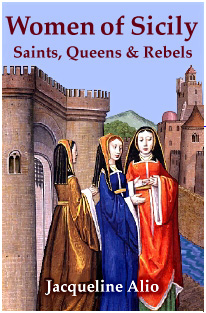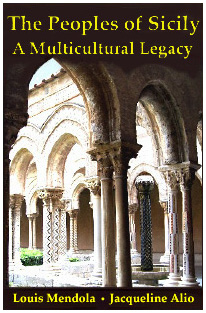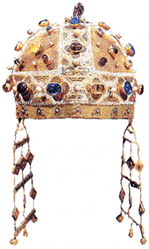...Best of Sicily presents... Best of Sicily Magazine. ... Dedicated to Sicilian art, culture, history, people, places and all things Sicilian. |
by Jacqueline Alio | |||
Magazine Index Best of Sicily Arts & Culture Fashion Food & Wine History & Society About Us Travel Faqs Contact Map of Sicily
|
In 1209, as the result of machinations by Pope Innocent III, the widow was betrothed to Frederick II von Hohenstaufen, King of Sicily and aspiring Holy Roman Emperor. As Frederick was barely fifteen years old, Constance could almost have been his mother, and shared the Christian name of that Norman princess. She eventually bore Frederick a son, Henry. Marital fidelity was not particularly important to most medieval kings and Frederick, no exception, fathered several illegitimate children during the time he was married to Constance and his subsequent wives; he also maintained a harem. Frederick's marriage to the royal widow was an opportune one. When the young sovereign reached his early majority, loyal knights were in short supply, and he recruited competent Saracen troops for precisely this reason. Conveniently, Constance brought with her hundreds of much-needed knights from Aragon, so the union was a good one from Frederick's point of view, even if most of this chivalric retinue eventually returned to Spain. During Frederick's long absence from 1212 until 1220, Constance acted as his regent (viceroy) in Sicily. This practice was not unknown, but in fact most queens of this era were "queen consorts" who rarely ruled in their own right. In Sicily, Constance confronted the revolts of the Saracens (Moors), a phenomenon which could not have been entirely unknown to a woman of Visigoth origins from the land of El Cid. She and Henry visited Frederick in Germany in 1216. Constance died at Catania in June 1222 and now rests in Palermo Cathedral beside Frederick in a sarcophagus of porphyry, the imperial stone that preserves the deceased so well. As punishment for his alliance with the Lombard League in 1234, an event preceded by complex politics and perhaps a touch of personal defiance, Constance's son, Henry, was ordered incarcerated by Frederick, ever the stern father. First imprisoned in Germany, Henry was then taken to Calabria, where he served an indefinite sentence. The young Hohenstaufen prince died in 1242, pre-deceased by his own two sons, falling off a horse on his way to visit his father, who (historians believe) was finally to grant him forgiveness. Frederick remarried twice, to the fifteen year-old Yolanda (Isabella) of Brienne, daughter of the king of Jerusalem (hence Frederick's claim to that throne), in 1225 and, following her death, to Isabella (Elisabeth) of England in 1235. By most accounts, Constance was the wife he loved most. Constance of Aragon was interred wearing the crown (and several stunning jewelled rings) today displayed in the Treasury, the museum of Palermo Cathedral. The crown was created in Byzantine-Arab style in Palermo by the Royal Jewelers from gold, pearls and large precious gems (sapphires, etc.), with enamelled details. Modified fleurs-de-lis are visible along the rim. (Often identified with French dynasties, the fleur-de-lis was in fact used as a royal motif by all of Sicily's Norman rulers from their first arrival in Palermo.) Were it not for her splendid imperial crown, the only one publicly displayed in Sicily, Constance might not be remembered at all. She was, however, a remarkable woman, even without the crown. She rests in Palermo Cathedral. About the Author: Historian Jacqueline Alio wrote Women of Sicily - Saints, Queens & Rebels and co-authored The Peoples of Sicily - A Multicultural Legacy. | ||
Top of Page |


 To historians, the phrase "the crown" (much like "the throne") usually refers to royal authority, implying that an actual crown is one of those few objects that assumes its truest meaning only when it is worn by the person for whom it is intended. After all, simply wearing a crown doesn't make one a king or queen. If her crown is an enduring image, the remarkable Queen Constance herself is, at best, a footnote to history. Her presence in Sicily was the first significant involvement of the Aragonese dynasty with the Kingdom of Sicily, and something that would be remembered during the Vespers uprising in 1282 --following which the Aragonese-Spanish dynasty subsequently ruled Sicily for several centuries. Constance was a daughter of King Alfonso II of Aragon and Sanchia of Castile and Leon. She wed Emmerich (Imre), son of King Bela III of Hungary. Emmerich succeeded his father in 1196. As queen, Constance bore an heir, Ladislas, in 1199. When Emmerich died in 1204, the very young Ladislas succeeded to the throne as Ladislas III with Constance as nominal regent. This child king died the following year. This sad event changed the course of the queen's life, for her presence at the Hungarian court was no longer needed, and Constance eventually returned with her entourage to Aragon. Her sojourn there was not to last long.
To historians, the phrase "the crown" (much like "the throne") usually refers to royal authority, implying that an actual crown is one of those few objects that assumes its truest meaning only when it is worn by the person for whom it is intended. After all, simply wearing a crown doesn't make one a king or queen. If her crown is an enduring image, the remarkable Queen Constance herself is, at best, a footnote to history. Her presence in Sicily was the first significant involvement of the Aragonese dynasty with the Kingdom of Sicily, and something that would be remembered during the Vespers uprising in 1282 --following which the Aragonese-Spanish dynasty subsequently ruled Sicily for several centuries. Constance was a daughter of King Alfonso II of Aragon and Sanchia of Castile and Leon. She wed Emmerich (Imre), son of King Bela III of Hungary. Emmerich succeeded his father in 1196. As queen, Constance bore an heir, Ladislas, in 1199. When Emmerich died in 1204, the very young Ladislas succeeded to the throne as Ladislas III with Constance as nominal regent. This child king died the following year. This sad event changed the course of the queen's life, for her presence at the Hungarian court was no longer needed, and Constance eventually returned with her entourage to Aragon. Her sojourn there was not to last long.